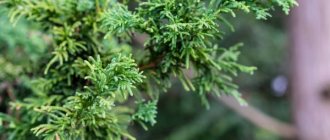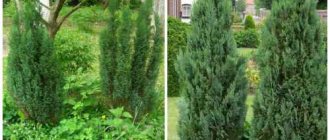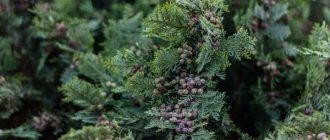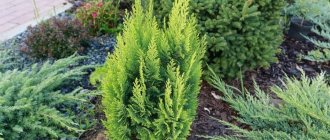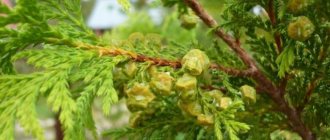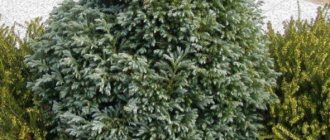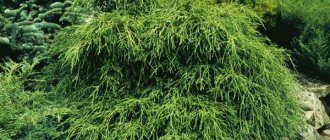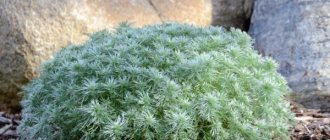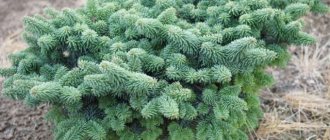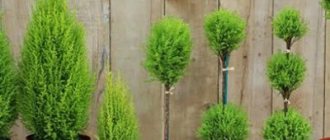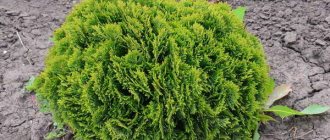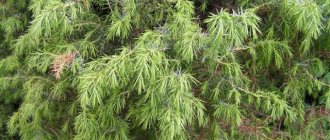Description of the plant
Cypress obtuse Nana Gracilis is a coniferous shrub with a very decorative crown. There are two types of plant foliage: conical and asymmetrical. Exquisite shoots reminiscent of shells give it a charming appearance. The cypress tree has brightly colored needles that shine and shimmer in the sun. There are two types of needles: light green and dark green. This species can be classified as a slowly growing species; an adult Nana obtuse cypress reaches five meters.
The plant is frost-resistant, but does not tolerate drought. This variety is excellent for growing in the garden. The plant should be planted in sunny areas, but light shade will do. The shrub needs high humidity. Currently, many different dwarf varieties have been bred that are ideal for decorating a green border or alpine hill. The blunt cypress can withstand severe winter frosts much better than other species, so it can be easily grown in the middle zone.
Description and characteristics
The Latin name of the variety is Pinus nigra Nana. An adult shrub grows up to 3 m in height, 4 m in width, and per year increases in size by no more than 5 cm. The crown is spherical or wide conical. The needles are dark green, up to 10 cm long, not very prickly, hard, grow densely, collected in bunches of 2 pieces. Nana pine cones are yellowish-brown in color and make the plant decorative, standing out against the background of dark pine needles.
Characteristics characteristic of the variety:
- winter-hardy, but in the absence of snow cover it can freeze slightly;
- undemanding to soil composition, prefers drained, lime-containing soil, although acidity is not of great importance;
- does not tolerate dense soil and salinity;
- grows slowly on dry soils, prefers moist ones;
- resistant to fungal diseases;
- light-loving, loses its decorative effect in the shade, gets sick, and can die;
- adapts to urban conditions;
- lives about 100 years.
The crown is spherical or wide conical.
Varieties and varieties
There are only seven species, three of which come from America and four from Asia. In Russian gardens, varieties of Japanese selection are most often found. There are dwarf, pyramidal and weeping varieties.
Popular varieties:
- Nutkansky is one of the interesting weeping species. Shrubs of this type grow slowly and withstand frosty winters. If the winter period is cold and there is little snow, it is recommended to cover the cypress tree.
- Cypress obtuse Rashahiba is an evergreen shrub. The crown is wide-pyramidal in shape. It grows up to 2 m in height. The plant has a very interesting color: from dark green in the middle to greenish-yellow and light yellow shoots. The growths are initially yellow in color, but turn green over time. The plant is suitable for fertile, well-drained soil with neutral acidity. It is better to plant the plant in a sunny place. Mulching the soil is mandatory. High frost resistance. Cypress looks great in garden plots.
- Lawson Cypress has many dwarf varieties and is widely known among gardeners. This species does not tolerate cold well, so it is not easy to grow in the middle zone.
- Pea cypress is a beautiful frost-resistant and unpretentious variety. The plant needs fertile soil and sun.
- Cypress obtuse Teddy Bia is a leisurely growing species with an asymmetrical crown shape, with reddish-brown bark. Cypress reaches a height of 1.2 m. The crown is up to one meter in diameter. Scaly emerald needles with delicate green new growths. The bush resembles a teddy bear, which you want to touch every time you pass by. The shoots look like ferns.
The plant prefers moderately moist fertile soils. In order for the needles to be bright in color, they need to be planted in a sunny or partial shade location. Cypress can withstand frosts down to -29°C and needs light shelter when young. Great for Japanese-style garden plots. In addition, Teddy Cypress can be grown in pots to decorate balconies and terraces.
Description of the variety
Cypress pea Filifera Nana is one of the few dwarf representatives of this species of coniferous plants. In adulthood, the bush reaches a height of 40–50 cm; the plant can spread 100–120 cm in diameter. Ephedra grows very slowly, increasing in size by 5–6 cm per year.
The shape of the cypress bush Filifera Nana is close to cushion-shaped and weeping. Numerous branches stretch upward from the short trunk, then fall down. The shoots are cord-like, covered with scaly short needles. The color of the needles is emerald, with barely noticeable white streaks.
Every year, many small brown cones ripen on the plant, which contrast effectively with the green delicate needles.
The shape of the cypress bush Filifera Nana is close to cushion-shaped and weeping.
The perennial creates the impression of airiness and tenderness. It looks impressive in a single composition on the lawn or in a rocky garden. The following are added to the company of the cypress Filifera Nana:
- conifers with a different needle structure and needle structure (spruce, columnar thuja, juniper);
- heathers;
- bright low-growing flowers (pansies, flax, marigolds).
In landscape design, conifers are actively used in Japanese and Chinese styles of site design.
The variety is photophilous and does not tolerate drying out of the soil and air. Needs feeding several times a season. Frost resistance is average, freezes at temperatures below -25 degrees.
Planted in a flowerpot, cypress feels great in a limited space. A container with ephedra can be moved around the site, creating new plant compositions.
It looks impressive in a single composition on the lawn or in a rocky garden.
Plant selection
It is recommended to buy planting material in special nurseries. Plants must be in pots.
In order to check how the cypress tree stays in the pot, it must be turned over; if the soil does not fall out, then such a plant should be purchased. The young plant should have a lush green color without the characteristic features of drying out.
Indoor cypress
Varieties intended for home cultivation belong to the category of slow-growing dwarf plants:
- Elwoodii - the variety is represented by different types, differing in the color of the needles (it can be white-green, golden, bluish);
- Minima Aurea - a plant with a pyramidal crown grows to a maximum of 30 cm, it has a bright yellow color;
- Golden Mop - the bush has a mop-like crown, consisting of drooping branches with golden needles;
- Andalyensis - thuja-like cypress of a bluish-green color with a blunt dense crown
- Сonica is a bluish-green bush with a pin-shaped crown.
Related article:
Barberry Thunberg Admiration
Tall trees belonging to the pea-bearing, Lawson, and Nootkan species are formed in a special way - bonsai is grown at home.
Cypress obtuse: planting and care
In the autumn, you need to dig a hole for the cypress tree. It is advisable to choose a sunny place without drafts. Approximately 80–90 cm deep and 60 cm wide you need to dig a hole. Drainage is installed at the bottom; the plant does not like stagnant water near the roots. Expanded clay, crushed bricks, and stones are suitable for the drainage system. Recommended layer – 20 cm.
In spring, the hole must be filled approximately halfway with nutritious soil. In general, plants grow best in fertile soils. For this reason, the pit must contain a mixture of humus, peat and sand. Before planting, add mineral fertilizers and compost. Next, the cypress tree is placed in a hole and covered with earth. Mulch with straw, sawdust or peat, creating a layer about 7 cm thick, and water. Mulch retains moisture in the soil and also prevents the growth of weeds.
Cypress planting rules
This is not to say that planting and caring for cypress trees is a complex and time-consuming process. However, growing these noble plants requires the gardener to have certain knowledge and experience.
- Boarding time
Spring. Autumn is a less suitable period. If the seedling does not have time to take root, there is a chance that it will not survive the coming winter.
- Selecting a location
Cypress loves sun and light partial shade.
Cypress varieties with yellow-green needles require more sun than varieties with blue or dark green needles.
Like any coniferous plant, the cypress tree needs to form a stable connection with symbiotic fungi, due to which the cypress tree receives an additional portion of nutrients. And mushrooms, as you know, love moisture and good soil. Light loams and wet sandy loams are the best option for planting.
The area where the cypress tree will grow must be sheltered from cold northern winds and strong drafts.
- Planting material
Before purchasing, you should carefully inspect the plant. It is strictly not recommended to take wilted specimens with dried needles.
It is better to purchase cypress seedlings from specialized nurseries
Planting a seedling in open ground step by step:
- In the fall, dig a hole 1 m deep, 0.6 m in diameter. Cover the bottom with a layer of expanded clay and sand, 20 cm thick. Prepare a nutrient mixture (humus, turf soil, peat in a ratio of 2:2:1), fill half of the planting hole with it and leave it like this until spring. If you are planning a group planting, you should remember that the distance between the planting holes must be at least 1 m.
- In the spring, approximately at the beginning - mid-April, you can start planting.
- Water the hole and soak the earthen ball with the roots of the seedling with Kornevin's solution.
- Carefully lower the plant into the center of the hole so that the root collar protrudes 10-20 cm above the soil. After a while, the ground will subside, the seedling will sink, and the root collar will almost be level with the soil surface.
- Remove the cover, if there is one, cover the roots with the remnants of the nutrient mixture prepared last year and lightly press down with your palms.
- Pour a bucket of water into the root circle. After planting, the cypress tree needs to be watered once a week.
- After the soil in the tree trunk circle has settled a little, add more soil to it and mulch it.
Planting a cypress tree in a permanent place and tips for care.
Reproduction
Obtuse cypress reproduces in three ways - by seeds, layering, and cuttings. The last method is considered the most common.
- Professional breeders use seeds as a propagation tool. They are collected in the fall and dried at +40° C. Cypress seeds are stored at +5° C. They can retain their germination capacity for up to 15 years. To awaken seeds, stratification is needed. To do this, cypress seeds are sown in a container with a mixture of sand and peat. If you plant cypress trees in December, they should sprout by early April. The container with the seeds is placed in the basement for three months, then moved to a bright room in which the air temperature is maintained at +18 ° C. The soil in the containers should be moistened, and when the first shoots appear, they are watered moderately. In the spring, when the soil and air warm up, the sprouts should be transplanted to a shaded place on the site.
- Reproduction by layering. They are formed in the usual way - the lower branches of the plant are bent to the ground and dug in at the beginning of spring. On the shoots where the buds are located, it is necessary to make cuts for the rapid appearance of roots. The upper part of the layering is tied to a peg. Starting next spring, the cypress tree can be separated from the bush and replanted in a new place.
- Propagation by cuttings is the simplest and most reliable way. The tips of the shoots are cut to a length of at least 15 cm. Next, the needles are removed from below and the cuttings are placed in a container enriched with a nutrient medium. For quick rooting, they create a greenhouse zone effect: cover the containers with covering material or plastic film and constantly moisten the substrate. It is recommended to carry out cuttings in the spring, and in the fall they can be transplanted into the garden. In the first winter, to prevent the cold from damaging the roots, it is recommended to cover the plant with fallen leaves.
Nutkan
The international name in Latin is Chamaecyparis nootkatensis . Similar to Lawson's cypress; the main difference is the crown. At first it is narrow conical, later it becomes wide pyramid-shaped. The ascending shoots hang down at the ends. The bark is brownish-gray, cracks with age, and comes off in thin sheets. The needles are scale-like, sharp at the top. The species blooms in April. Female cones change color from brownish-red to brown with a bluish tinge and ripen the following year in May.
The ascending shoots hang down at the ends.
Varieties of Nootkan cypress:
- ‚Pendula‛;
- ‚Glauca‛;
- ‚Aypea‛;
- ‚Jubilee‛;
- ‚Lutea‛.
Chamaecyparis nootkatensis “Pendula” is a tree 10–15 m high with a straight trunk and weeping loose asymmetrical branches. At the age of 10 years it reaches 3 m, per year it increases by 15–25 cm. The Pendula cypress variety is undemanding to the soil, light-loving, and shade-tolerant. Requires abundant watering in summer and responds well to fertilizing with organic matter and complex mineral mixtures.
Glauca (Chamaecyparis nootkatensis "Glauca") is a tree 15–20 m high, reaching a maximum height of 40 m. The crown is neat, cone-shaped, expanding at the bottom to 5–7 m in diameter. The shoots are raised, the needles are hard, scaly, with a bluish tint. Glauka is undemanding about soil fertility, but prefers fairly moist areas. Young seedlings must be protected from wind and frost for the winter.
Trimming
This procedure must be done in the spring and autumn. In the spring, as soon as the snow melts, remove dry and frozen branches of pine needles and do pruning, cutting off no more than a third of the entire green mass of the plant. The cuts are made obliquely with sharp and clean instruments. As a rule, cypress trees are given a cone-shaped appearance. Newly planted plants are not pruned. The first pruning can be done a year after planting the plant. To make the crown thicker and more lush in the autumn, at the end of the growing season, a third of the total growth is cut off. You should also remove any bare branches as they will dry out.
Tuevidny
The international Latin name of the species is Chamaecyparis thyoides . Depending on the variety, it is represented by shrubs and trees; in cultivation it grows in height by 0.4–3.5 m, in container cultivation it is 1–1.5 m, in nature it reaches 20–35 m. The crown is often cone-shaped and narrow. The trunk is straight, up to 0.8 m in diameter, ¾ covered with thin, gradually expanding branches. The bark is ash-gray to brownish-red, smooth at first, later cracking and becoming unevenly furrowed.
The color of the foliage changes over the year from bluish-green to brownish.
Thuja cypress seedlings are covered with needle-like needles up to a year old; later they become scale-like, 0.2–0.4 cm long. The smell of the species is pleasant, reminiscent of cedar. The color of the foliage changes over the year from bluish-green to brownish. The cones are spherical, 0.4–0.9 cm in circumference, covered with 6–12 scales, covering 1–2 seeds. The fruits are initially green or purple and turn brown when ripe. They open in the second half of autumn, releasing 5–15 ripened seeds.
Varieties of thuja cypress:
- ‚Aurea‛;
- ‚Ericoides‛;
- ‚Hopkinton‛;
- ‚Ericoides‛;
- ‚Andelyensis‛;
- "Blue Sport";
- ‚Little Jamie‛;
- ‚Variegata‛.
Ericoides is a cypress tree with an openwork columnar crown. The variety differs from others in the color of its needles. Young needles are blue, old ones are grayish-green. In winter, purple and bronze shades appear. Plant parameters 1.5x2–2.5 m, grows very slowly. The branches have few branches, but are dense and directed in different directions. Coniferous wood is used for park alleys, alpine slides, and Japanese gardens.
On a note! Thuja cypress variety Top Point is used to create bonsai.
Care
Despite the fact that cypress trees are rather undemanding plants, to grow them successfully you must adhere to basic care rules. As soon as the new Nana cypress tree is planted, it needs to be fed.
During the summer season, plants need frequent watering. In spring, organic and inorganic fertilizers should be applied to the shrubs. Any complex for garden plants is suitable. Up to ten buckets of water are poured under each cypress tree. In dry times, it is necessary to increase the frequency of watering and the amount of water. But do not forget that the plant does not tolerate stagnant water. The soil is kept moist at all times and not filled with water. Cypress obtuse, the care of which involves sprinkling, loves this procedure very much, so once a week water it with a diffuse stream from above. It is recommended to mulch the soil around the bushes. To do this, mix peat with wood chips. In the middle of the summer season, the last feeding is done. Next, the cypress tree begins to prepare for the dormant period. If you apply fertilizer in the fall, this will significantly reduce its frost resistance.
Pests and diseases
The blunt cypress is rarely attacked by pests and practically does not get sick. However, sometimes troubles can still arise. As a rule, shrubs are damaged by scale insects and spider mites. If the plant turns yellow and the needles begin to fall off, then most likely there is a spider mite infestation. The drug “Nuprid” will help to cope with this problem. Mature plants are treated once a week. Acaricides can also help.
Scale insects suck the juice from the plant, and it begins to dry out, the needles fall off, and the bush may die. “Nuprid” will also come to the rescue. Treat infected bushes once a week.
Shrubs are most affected by root rot. Fungus can appear due to incorrect moisture content or excess moisture. Therefore, you do not need to pour too much water, and be sure to install drainage when planting. If the bush has been damaged by root rot, then the plant must be destroyed. If you see the fungus at an early stage, then you need to dig up the bush, cut off the damaged roots and treat them with a fungicide. It is recommended to sprinkle the root system with charcoal. Next, dry the wounds in the air, and then plant the cypress tree in another place, following the planting technology.
Landscape design
Cypress is a bright and unpretentious plant. Shrubs can be used to beautifully decorate the area around a country house.
In order for cypress to grow and develop well, you need to choose the right variety recommended for your region. Obtuse cypress Nana Gracilis is grown singly or in groups. If you plant several groups of shrubs, they will give the area the effect of a Mediterranean landscape, especially when planted near a fence. A hedge of cypress trees looks very impressive and decorative. Plants in cold regions of the country can be grown in tubs: taken outside in summer and hidden indoors in winter. Don't forget about wet soil. In addition, shrubs can be used to create fun and interesting patterns in flower beds. Perhaps the only difficulty is frequent watering of the plant. Otherwise, care is quite simple, the blunt cypress rarely gets sick and looks very attractive.
Description
Cypress belongs to the Cypress family and is found naturally in Japan and North America. In the 18th century, this crop began to be grown in Europe. Taking the most unpretentious species as a basis, breeders have developed over 200 varieties.
The plant has a well-developed branched root system. The bark is scaly, red-brown or black-brown. The crown can be pyramidal, columnar, or cone-shaped. Depending on the type, the height is 0.5-70 m. The branches can be horizontally spread or drooping. The color of soft, scale-like needles depends on the type, variety, and age of the cypress tree - there are different shades of green (from dark to light green), the needles can be golden, variegated, or blue.
Related article:
What can be planted in September: 7 options for shrubs and trees
Male (yellow or red) and female (green) flowers appear at the tips of the shoots. Tuberous cones of a spherical shape open after ripening. Each scale contains 2 seeds - they are capable of sprouting. The varietal characteristics of the seedlings are split and only the specific characteristics are transmitted.
If there is a risk of freezing, low-growing varieties are grown in pots, taking them outside only in the warm season.
